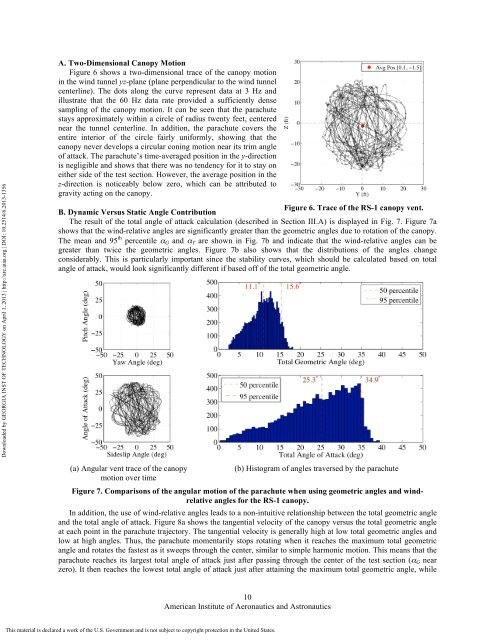Aerodynamic Stability and Performance of Next-Generation ...
Aerodynamic Stability and Performance of Next-Generation ...
Aerodynamic Stability and Performance of Next-Generation ...
Create successful ePaper yourself
Turn your PDF publications into a flip-book with our unique Google optimized e-Paper software.
Downloaded by GEORGIA INST OF TECHNOLOGY on April 1, 2013 | http://arc.aiaa.org | DOI: 10.2514/6.2013-1356<br />
A. Two-Dimensional Canopy Motion<br />
Figure 6 shows a two-dimensional trace <strong>of</strong> the canopy motion<br />
in the wind tunnel yz-plane (plane perpendicular to the wind tunnel<br />
centerline). The dots along the curve represent data at 3 Hz <strong>and</strong><br />
illustrate that the 60 Hz data rate provided a sufficiently dense<br />
sampling <strong>of</strong> the canopy motion. It can be seen that the parachute<br />
stays approximately within a circle <strong>of</strong> radius twenty feet, centered<br />
near the tunnel centerline. In addition, the parachute covers the<br />
entire interior <strong>of</strong> the circle fairly uniformly, showing that the<br />
canopy never develops a circular coning motion near its trim angle<br />
<strong>of</strong> attack. The parachute’s time-averaged position in the y-direction<br />
is negligible <strong>and</strong> shows that there was no tendency for it to stay on<br />
either side <strong>of</strong> the test section. However, the average position in the<br />
z-direction is noticeably below zero, which can be attributed to<br />
gravity acting on the canopy.<br />
Figure 6. Trace <strong>of</strong> the RS-1 canopy vent.<br />
B. Dynamic Versus Static Angle Contribution<br />
The result <strong>of</strong> the total angle <strong>of</strong> attack calculation (described in Section III.A) is displayed in Fig. 7. Figure 7a<br />
shows that the wind-relative angles are significantly greater than the geometric angles due to rotation <strong>of</strong> the canopy.<br />
The mean <strong>and</strong> 95 th percentile α G <strong>and</strong> α T are shown in Fig. 7b <strong>and</strong> indicate that the wind-relative angles can be<br />
greater than twice the geometric angles. Figure 7b also shows that the distributions <strong>of</strong> the angles change<br />
considerably. This is particularly important since the stability curves, which should be calculated based on total<br />
angle <strong>of</strong> attack, would look significantly different if based <strong>of</strong>f <strong>of</strong> the total geometric angle.<br />
(a) Angular vent trace <strong>of</strong> the canopy<br />
motion over time<br />
(b) Histogram <strong>of</strong> angles traversed by the parachute<br />
Figure 7. Comparisons <strong>of</strong> the angular motion <strong>of</strong> the parachute when using geometric angles <strong>and</strong> windrelative<br />
angles for the RS-1 canopy.<br />
In addition, the use <strong>of</strong> wind-relative angles leads to a non-intuitive relationship between the total geometric angle<br />
<strong>and</strong> the total angle <strong>of</strong> attack. Figure 8a shows the tangential velocity <strong>of</strong> the canopy versus the total geometric angle<br />
at each point in the parachute trajectory. The tangential velocity is generally high at low total geometric angles <strong>and</strong><br />
low at high angles. Thus, the parachute momentarily stops rotating when it reaches the maximum total geometric<br />
angle <strong>and</strong> rotates the fastest as it sweeps through the center, similar to simple harmonic motion. This means that the<br />
parachute reaches its largest total angle <strong>of</strong> attack just after passing through the center <strong>of</strong> the test section (α G near<br />
zero). It then reaches the lowest total angle <strong>of</strong> attack just after attaining the maximum total geometric angle, while<br />
10<br />
American Institute <strong>of</strong> Aeronautics <strong>and</strong> Astronautics<br />
This material is declared a work <strong>of</strong> the U.S. Government <strong>and</strong> is not subject to copyright protection in the United States.
















